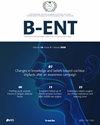A Comparison of Nasal Mucociliary Clearance Time in COVID-19 and Variant COVID-19 Patients
IF 0.2
4区 医学
Q3 Medicine
引用次数: 0
Abstract
Objective: The aim of this study was to compare nasal mucociliary clearance times in coronavirus disease 2019 and variant coronavirus disease 2019 patients and a control group. Methods: The study was conducted in Karaman Training and Research Hospital between April 2021 and June 2021. Three groups were formed. Group 1 included 41 coronavirus disease 2019 patients, group 2 included 41 patients diagnosed with variant coronavirus disease 2019, and group 3 included 42 patients from the ear, nose, and throat polyclinic with no nasal symptoms. The primary outcome was nasal mucociliary clearance time and sinonasal outcome test-22 scores. Results: The mean nasal mucociliary clearance time was 12.87 +/- 2.46 minutes in group 1, 14.02 +/- 2.95 minutes in group 2, and 8.57 +/- 1.25 minutes in group 3. Nasal mucociliary clearance time was significantly different between groups 1 and 3 and between groups 2 and 3 but not between groups 1 and 2 (P =.07). The nasal mucociliary clearance times of group 2 were determined to be higher than those of group 1. The mean sinonasal outcome test-22 score was 24.70 +/- 6.65 in group 1 and 23.92 +/- 7.01 in group 2, with no significant difference determined between the groups (P >.05). Conclusion: Nasal mucociliary clearance time was higher in coronavirus disease 2019 and variant coronavirus disease 2019 patients than in the control group. There is a need for further studies to be able to understand the underlying pathophysiology of prolonged nasal mucociliary clearance time.COVID-19与变异型COVID-19患者鼻黏膜纤毛清除时间的比较
目的:本研究的目的是比较2019冠状病毒病和2019变异冠状病毒病患者和对照组的鼻粘膜纤毛清除时间。方法:本研究于2021年4月至2021年6月在卡拉曼训练研究医院进行。组成了三个小组。第一组包括41名2019冠状病毒病患者,第二组包括41例被诊断为2019变异冠状病毒病的患者,第三组包括42名来自耳鼻喉综合诊所且无鼻腔症状的患者。主要结果是鼻腔粘液纤毛清除时间和鼻腔结果测试-22分。结果:第1组的平均鼻粘膜纤毛清除时间为12.87+/-2.46分钟,第2组为14.02+/-2.95分钟,第3组为8.57+/-1.25分钟。第1组和第3组之间以及第2组和第三组之间的鼻粘膜纤毛清除时间有显著差异,但第1组与第2组之间没有差异(P=.07)。第2组的鼻粘膜睫状体清除时间高于第1组。第一组的平均鼻腔结果测试-22分为24.70+/-6.65,第二组为23.92+/-7.01,两组之间没有显著差异(P>0.05)。结论:2019冠状病毒病和2019变异冠状病毒病患者的鼻腔粘液纤毛清除时间高于对照组。有必要进行进一步的研究,以了解鼻粘膜纤毛清除时间延长的潜在病理生理学。
本文章由计算机程序翻译,如有差异,请以英文原文为准。
求助全文
约1分钟内获得全文
求助全文
来源期刊

B-Ent
Medicine-Otorhinolaryngology
CiteScore
0.60
自引率
0.00%
发文量
13
期刊介绍:
Throughout its history, the Royal Belgian Society of Oto-rhino-laryngology, Head and Neck Surgery, the home society of B-ENT, aims to disseminate both the scientific and the clinical knowledge of otorhinolaryngology field primarily in Belgium and its regions. In accordance with this aim, publishing a scientific journal has become the number one objective of the Society. Accordingly, B-ENT contributes to the scientific memory of Belgium considering its deep-rooted history.
 求助内容:
求助内容: 应助结果提醒方式:
应助结果提醒方式:


